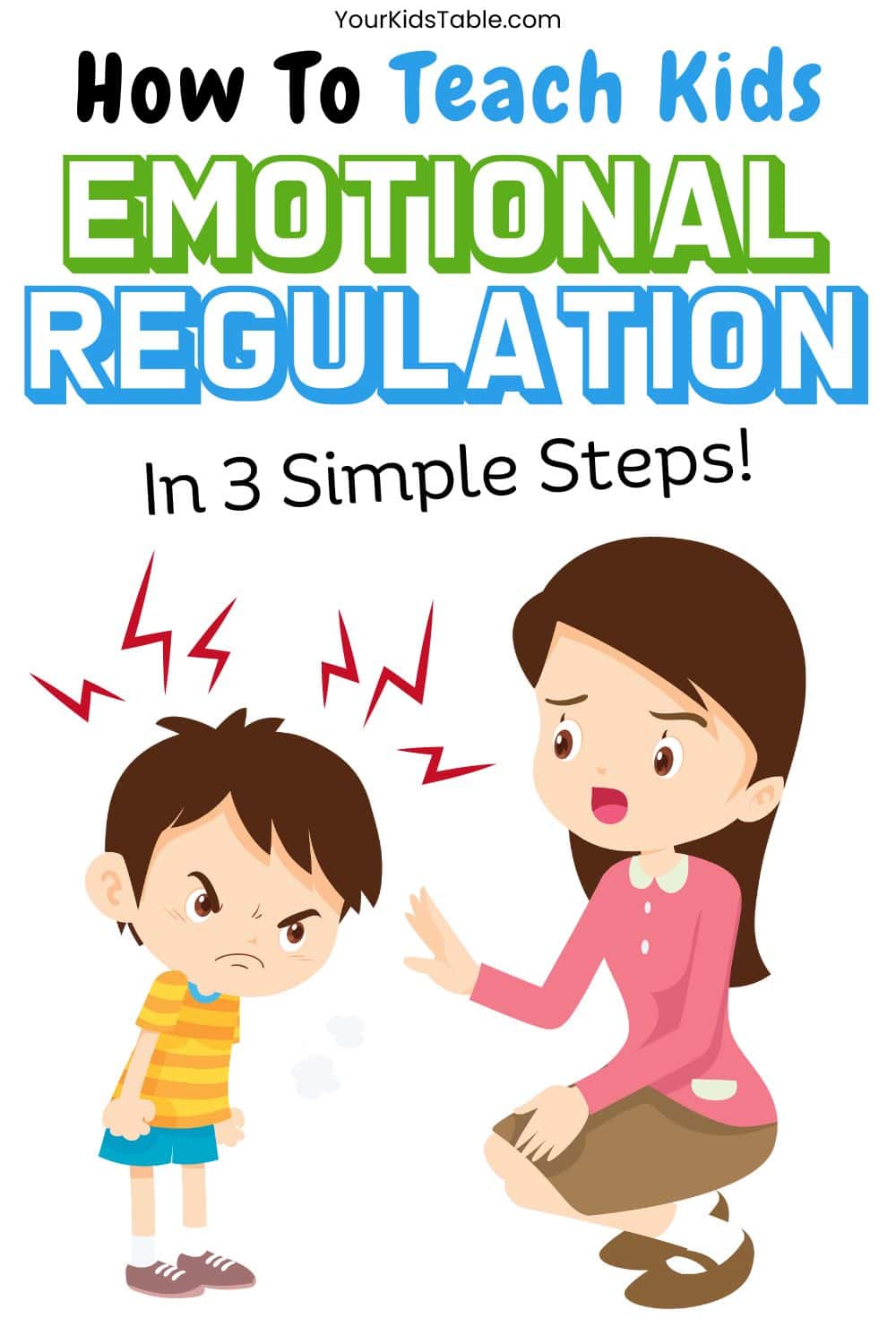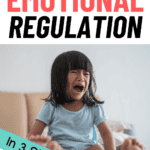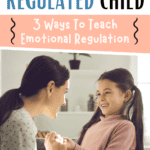Learn 3 simple and clear steps to teaching kids how to emotionally regulate from a pediatric occupational therapist and mom of 3.
Does your kid struggle with big emotions, having them often, getting stuck in them or having kind of behaviors and reactions to what you suspect are emotions? But they are not acknowledging or dealing with but you are seeing the behavior as a response?
If so, what you are seeing is that they have a need to develop a skill called emotional regulation. Honestly this is something that we all have to work on, something that I am working on as an adult because I didn’t have all of the skill development as a child.
And I think most of us can see some of that in ourselves as adults and we want to help our kids develop the resiliency of being able to deal with and cope with the difficult emotions that are surely to come.
That we are going to deal with on a daily basis, and of course our kids that have difficulties with sensory processing have sensory issues and are so much more likely to have emotional regulation difficulties which is an executive functioning skill.
How can you help your child develop emotional regulation?
This is a huge topic in and of itself but I want to share three specific things that you can literally start doing today after you watch this video and start developing that emotional regulation skill in your child.
And maybe even a little bit in yourself too if you have that need just like me.
First I want to tell you a story kind of illustrating what each of these three components of emotional regulation can come into play right in the moment when your child is having an emotion that they don’t know what to do with or are kind of responding in a big way.
So recently my son had said “something is wrong with me.” This was about 8:00 at night. It was towards the end of his bedtime routine.
He had brushed his teeth, he was laying on the floor, and he said it sort of matter of fact and it caught my attention. And I was tempted to be honest for a second to say “what do you mean something’s wrong with you? You’re okay. Let’s get up and go to bed.”
And I think that that is kind of our default in part, if you’re like me and we’re raised in the 80s and ’90s that this is the fall back that we were taught.
As well I was tired at the end of the day I didn’t have much more to give but thankfully something inside of me said to ask “what do you mean? Tell me more about that.”
“I don’t know,” he said. “Something is just wrong with me”
It was at that moment that I remembered that just a few minutes earlier he had said “I don’t want to go to school tomorrow.”
Now this has been a theme throughout this whole third grade year of his. It has been a big transition to a different school and he has struggled all year with just kind of not liking school, not wanting to be there even though academically he is doing fine so I said “okay why don’t you come up here with me?”
I was sitting on the bed and I could tell that this was probably anxiety which was an emotion that we had not talked about yet.
And so my first step, and the first thing that I want to encourage you to do when your child is struggling with emotions they either don’t understand, don’t know how to name as my son, or are taking over is to share your regulation with them.
Now I had to stop for a minute and take a deep breath. I was actually in a pretty regulated state. I had to be very intentional about what I was about to do. And the truth is, I am not always in a regulated state.
I struggle with a lot of anxiety myself and it is something that I have not always been fully aware of.
Actually until I was in my late 20s and even well into my 30s that I fully begin to understand how much there was this undercurrent of anxiety that was always playing a role in my life because I didn’t have those emotional regulation skills from when I was a child to cue me in to how I was feeling.
But the first step, I’m getting a little ahead of myself, is to share that regulation.
So I invited him up, and I snuggled with him. Now I’m giving him deep pressure as I’m doing this so this is a sensory strategy because I know that that proprioceptive input is going to start to calm his nervous system down.
I deliberately start taking slow breaths so that he feels the rhythm of my breaths as he leans into me. I take some time to say nothing just so that his body has a chance to feel my regulation and then when I speak I make sure that I am speaking calmly.
I am in an even tone as I move on to the second strategy for building emotional regulation: I need him to name how he’s feeling.
Now I suspected that this was anxiety, but I didn’t want to put those words in his mouth yet.
I wanted to help him see that connection. I know he’s heard that word before but I wasn’t sure if he understood quite what that meant for his body and potentially I might have been wrong. So I said “how are you feeling?” He said “I don’t know. So that told me that that question was too broad for him.
So I needed to narrow it in a little bit for him and so I again, taking deep breaths the whole while, making sure I’m pacing myself and not peppering him with questions, I then say “How does your head feel? He says “like it’s going crazy.”
I know that feeling when your thoughts are bouncing so fast and I realized, yes surely seemed like I was correct. So then I asked him “how does your heart? Feel my heart. Always feels tied up and twisted in knots when I am anxious, so I wondered if the experience was his too.
Now please keep in mind that his feelings of anxiety may sit in different places of his body but how do we know we are anxious? How do we know we are happy? How do we know we are angry? It is because we feel it somewhere in our body and if we feel it somewhere in our body being able to name “oh when my chest tightens up, oh my gosh I think I’m anxious.”
Then we can start to deal with it. But here I’m breaking it down for him and we’re just beginning to name what it is that he’s feeling. So I ask him “how does your heart feel? And he says “it feels tight” Okay so I ask one more question: “How does your belly feel?” “It hurts a little bit.”
It’s another common area for anxiety. Now I could have kept going. I could have asked about different body parts, but that had given me enough information to feel pretty confident in the fact that he was experiencing anxiety so I said to him “it sounds like you’re feeling anxious. Do you know what that is?”
And so we talked about what anxiety was. I told him that that wasn’t a bad feeling but that it was a guide to us that we need to deal with something. It’s uncomfortable and we don’t like it but that’s why it’s there, it’s a signal. It’s a sign for us to do something about it.
So the third step I then used is using sensory calming supports to help him.
Now start to bring his nervous system down so that that heart tightness relaxes so that the thoughts stop going so quickly and we talked about taking deep belly breaths. Big belly breaths where we breathe in and have our whole stomach expand.
We have an entire tutorial on this on the blog that I will link up below to show you how to teach this to your child. And when we exhale we do a long exhale. When we watch our chest rise it’s the opposite of how we technically breathe so you think this is just a breathing activity this is actually actually a sensory experience because our interoceptive sense- that eighth sense- is responsible for all of our internal sensations. Our emotions are part of our interoceptive sense. So we worked on deep breathing.
So those three things are:
- Sharing my calm
- Naming the feeling
- Using sensory strategies
And there are many of them to help calm the nervous system down. These are three key ways that you can build the skill of emotional regulation in your child.
You will use it over and over again, and yes of course there are more things we can build on. If you would like to hear more about other emotional regulation strategies you can use when your child is dealing with and struggling with these big feelings let me know below.
I am so happy that you are here because together I believe we can raise a generation that knows how to respond to and accept and move through the many emotions that life brings their way.
If all of this sensory processing information is new to you, I highly recommend taking my free sensory workshop to learn valuable strategies for calming and regulating kids.
Something Big is Coming…
If you want to continue to build emotional regulation skills, build a deeper connection with your kid, and get support from other like-minded parents get on the waitlist for our brand new resource coming mid May, 2024.
It’s unlike anything we’ve done before, and I think you’re going to love it!
Learn More about Helping Kid Develop Regulation Skills:
4 Reasons I Had My Kid Tested for ADHD
Sensory Self Regulation: A Critical Skill for Kids with Sensory “Issues”
The Parent’s Guide to Sensory Processing Issues
3 Secret Strategies to Calm and Focus Kids with Sensory Activities
Alisha Grogan is a licensed occupational therapist and founder of Your Kid’s Table. She has over 19 years experience with expertise in sensory processing and feeding development in babies, toddlers, and children. Alisha also has 3 boys of her own at home. Learn more about her here.



does not offend me at all.
Well done Alisha ! You are right. We can help children with these big emotions. As an OT in the schools, I can not hug my students. I would be interested in calming strategies that do not necessarily involve touch. Some of my students are in middle school. Thankyou for sharing your story.
Thanks for this feedback, Samaya! I would start with weighted items or linear movement (Swing, rocking, etc.) but we have a ton of ideas on our sensory diet template if you haven’t looked at these yet!
Best,
Laura
Your Kid’s Table team member
I would like to learn more sensory strategies that you use for calming.
Please let me know where I can read about these.
Thank you,
Jan
I would like more information about sensory strategiest, thank you
Hi Alecia,
Have you taken our free sensory workshop yet? It’s a great place to start! Happy to point you somewhere else after this!
Best,
Laura
Your Kid’s Table team member
Hi Jan!
We have all kinds of resources for this, but a good place to start is this article on 8 activities for calming a sensory seeker. Let me know if I can point you to something else. There are lots of links within!
Best,
Laura
Your Kid’s Table team member